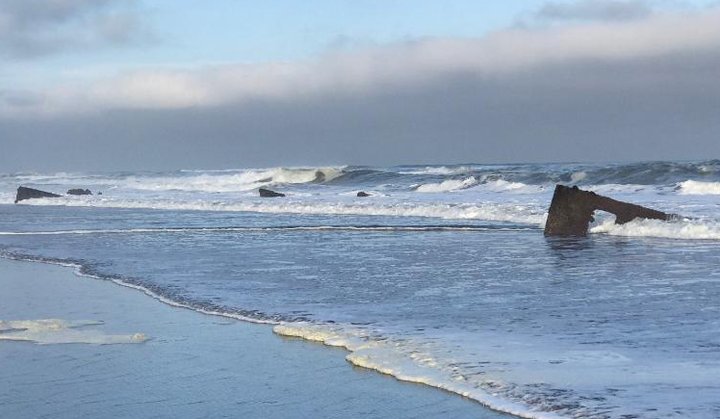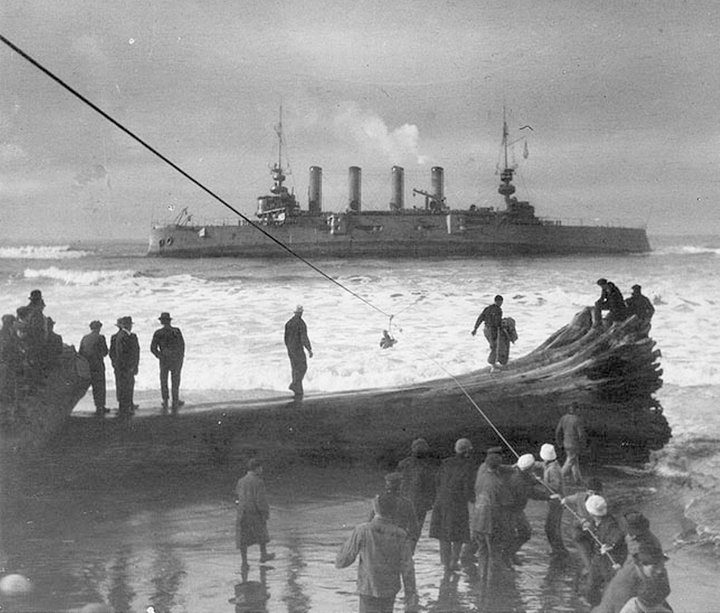For some folks living on the coast, a “minus two-footer” translates into “clam tide.” For Humboldtians with an interest in local history, an extreme low tide like this says one thing: Milwaukee! Here she is, all 10,000 tons of her, at 7 am last week:

Minus 1.9 tide, May 9, 2020. (Barry Evans)
OK, not a whole lot to see, I know. But even less than we saw eight years ago, again at a very low tide:

Minus 2.2 tide, June 5, 2012. (Kathleen Cameron)
It takes a bit of imagination, but what you have to visualize, standing on the Pacific beach a mile south of Samoa, is that you’re just seeing the very tip of the USS cruiser Milwaukee, stranded here on the early morning of January 13, 1917, three months before the US entered WW1.

Rescuers brought crewmen ashore two at a time using a breeches buoy. (US Naval Historical Center, public domain)
I’ve written on the wreck of the Milwaukee previously, so won’t go into a lot of detail here. Briefly, she was trying to extricate H-3, a 350-ton submarine that had beached in heavy fog (no radar or sonar back then) off our coast. Harvey Haislip, the inexperienced skipper of the Milwaukee, ignored the warnings of both the captain of the H-3 and local coastguards, insisting that the strong Pacific tides were no match for his ship and that two additional “anchor” ships would maintain his vessel at a safe distance offshore. His plan—to tow the H-3 back to deep water at high tide—was thwarted when the Milwaukee’s propellers cut the line to one of the two smaller ships, leaving just one inadequate anchor ship, the USS tug Iroquois, to prevent the cruiser from pivoting around on twin half-mile-long hawsers attached to the beached submarine. By dawn on the 13th, the Milwaukee was stuck fast on the sand…
…where she sits today. Not so much on the sand as under it. Every year, for the past 103 years, she has sunk lower and lower, so that now, just the tips of a few bulkheads can be seen at low tide. Judging by the photos above, those will be gone too in a few years.
The kicker to the story is that local construction company Mercer Fraser skidded and rolled the submarine that initiated the rescue attempt on logs three-quarters of a mile across the spit to re-launch her in the calm waters of Humboldt Bay. (Mercer Fraser had proposed to do this before the Milwaukee got into the action, but their low bid for the job—$18,000—was considered unrealistic.) You can read all about it in Ray Hillman’s book (it’s in the library) Shipwrecked at Samoa, California.
It’s easy to find the site: drive a mile-and-a-half south from the west end of the Samoa bridge to the oddly-sited tall rock on the right hand side of New Navy Base Road. You’ll see a plaque with the word “Milwaukee” at its base. Walk down to the beach and you’ll see—at a very low tide—all that remains above the sand. Just remember that there’s a 425-ft. long ship right beneath those few remnants.
Catch her while she’s still there!
CLICK TO MANAGE